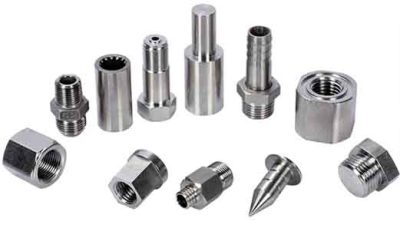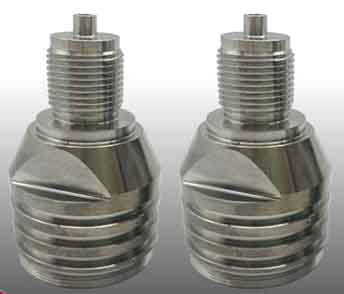Проблемы токарной обработки резьбы из нержавеющей стали на станках с ЧПУ и меры борьбы с ними
Шероховатость поверхности токарной резьбы с ЧПУ слишком низкая.. Наиболее распространенным явлением, возникающим при токарной обработке резьбы из нержавеющей стали на станках с ЧПУ, является: чешуйчатая рябь и феномен кусания ножа. Причинами этих явлений являются:
(1) The clearance angles of the two sides of the thread turning tool are too small, and the friction between the two sides of the cutting tool and the rear thread surface will deteriorate the machined surface. The influence of the thread rotation angle on the actual clearance angle of both edges must be considered during processing.
(2) Передний угол инструмента для токарной обработки резьбы слишком мал, а режущая кромка недостаточно острая.. Чипсы не могут быть разрезаны гладко, но частично сдавлены или оторваны, что должно привести к тому, что поверхность резьбы будет очень шероховатой. Когда передний угол слишком велик, прочность лезвия ослаблена и его легко носить, чип, и проткнуть нож, что с большей вероятностью вызовет вибрацию и рябь на поверхности резьбы. Поэтому, соответствующий передний угол следует выбирать в соответствии с различными материалами нержавеющей стали.. При токарной обработке резьбы из нержавеющей стали, устойчивой к концентрированной серной кислоте., следует использовать меньший передний угол, чем при обработке резьбы из нержавеющей стали 2Cr13.. Режущие кромки с обеих сторон токарного инструмента должны иметь очень узкие режущие кромки, чтобы избежать быстрого износа режущих кромок.. При резке 2Кр13, 1Кр17, 4Кр13, режущая кромка должна быть максимально острой, в противном случае будет непросто добиться требуемой хорошей шероховатости поверхности..

Процесс точения резьбы из нержавеющей стали
(3) лезвие нитеобрезателя затупилось, фактически, передний угол, задний угол от большого к маленькому, стружка, спрессованная в процессе жесткой формовки, так что сила резания увеличивается при повышенной вибрации резания, серьезное ухудшение обработанной поверхности. Поэтому, при токарной обработке резьбы из нержавеющей стали, лезвие всегда должно быть острым, а режущую головку необходимо своевременно заменять..
(4) Недостаточная фиксация токарных инструментов с резьбой., чрезмерно выдвинутые головки инструмента, недостаточная жесткость оправки инструмента, низкая точность станка, свободные шпиндели, loose tool holders and other factors can cause vibration and cause ripples on the threaded surface. Поэтому, you must pay attention to the operation of the machine tool, cutting tool and workpiece during operation to make the system sufficiently rigid. When installing the turning tool, in addition to ensuring a firm installation and no looseness, the tip of the turning tool should be slightly higher than the center of the workpiece by 0.2-0.5mm, and never lower than the center to avoid cutting the tool.
(5) Avoid using the straight forward method when turning stainless steel threads. Due to the long chip contact length on the left and right sides, it is prone to vibration, which increases the load on the tool tip, causes vibration and increases the resistance during chip removal, and scratches the surface of the workpiece. Поэтому, for the processing of stainless steel threads, it is best to choose the method of cross-turning threads. This method adopts the alternate lateral feed method, especially for the cutting of large-pitch threads and viscous materials. It is the most effective measure to solve the vibration problem. Since the cutting edges are used crosswise, the wear is even and the tool life can be prolonged.
(6) The matching degree of the cutting amount in the process of CNC cutting stainless steel threads directly affects the processing efficiency. If the cutting amount is too small, the tool wear will be aggravated, and if it is too large, the tool will collapse. Поэтому, the number of cuts and the feed per cut will have a decisive influence on the thread turning. Для достижения наилучшего срока службы инструмента, диаметр заготовки не должен быть больше диаметра основной резьбы 0,14 мм., следует избегать подачи на инструмент менее 0,05 мм.. Общий объем резания при механической обработке должен быть установлен на уровне около 0,1 мм., глубина первого реза должна быть 150-200% радиуса носа (р), и максимум не должен превышать 0,5 мм.. Для аустенитной нержавеющей стали, следует избегать подачи на рез менее 0,08 мм.. Пластины с обычными кромками и небольшим радиусом при вершине для внутренней резьбы могут увеличить количество резов при уменьшении глубины инструмента.. Размер резьбы нестабильен после токарной обработки нержавеющей стали на станке с ЧПУ.. После обработки потока. Используйте калибр для резьбовых колец, чтобы измерить “до конца” внешней резьбы невозможно ввести, or there are phenomena such as inconsistencies in the front and rear tightness and partial passage of the “stop end”.

Cooling lubricant for turning stainless steel thread
Reasons for these ills of thread:
(1) The thread profile is wrong. Even if the pitch diameter of the thread has reached the specified size, the thread ring gauge and plug gauge may still not be screwed.
(2) The thread is inverted. When measuring with a thread gauge, there is often a phenomenon that is restricted by the directionality. That is to say, it is tightened from one end and loosened from the other end, and even the phenomenon that the “до конца” cannot pass but the “stop end” passes instead.
(3) If the bottom diameter of the internal thread is too small, or the bottom diameter of the external thread is too large, the thread gauge will not be screwed in. This is because the turning tool wears and becomes dull, and there is extrusion during the cutting process, which makes the outer diameter or inner diameter of the thread squeeze out of burrs.
(4) When turning internal threads with a small diameter, the rigidity of the turning tool bar is limited by the size. During the turning process, it is easy to produce “give a knife”, and even the local size is large, which causes the local tolerance to be out of tolerance.
(5) When turning the stainless steel slender screw, due to the poor rigidity of the workpiece, deformation occurs during the turning process, resulting in dimensional errors on the thread.
(6) When turning the internal and external threads of stainless steel thin-walled workpieces, the workpiece will be locally deformed due to the force and cutting temperature, and the thread will also be locally out of tolerance. Поэтому, in order to solve the problem of “the thread gauge cannot enter”, corresponding measures must be taken for the above reasons, mainly from the aspects of correct installation and proper clamping of the workpiece.
The subtle role of cooling lubricating fluid in CNC thread cutting
Reasonable use of lubricating fluid can improve cutting conditions and achieve a multiplier effect. Attention should be paid when CNC cutting stainless steel threads:
Special requirements for cooling lubricants:
(1) Due to the toughness of stainless steel and the difficulty of being separated by cutting, the coolant is required to have higher cooling performance to take away a lot of heat.
(2) Due to the high viscosity and high fusion property, it is easy to produce built-up edge during thread cutting, so the coolant should have high lubricating performance.
(3) The coolant is required to have good permeability, which can penetrate into the fine gap lines of the metal area during cutting, so that the chips are easily broken.
(4) It must have a certain washing function.
Use several suitable coolants
(1) Vulcanized oil has good cooling performance and lubricating performance, and can be divided into direct and indirect according to different preparation methods. The formula of direct fluidized oil is 98% mineral oil and 2% sulfur. The indirect sulfurized oil formula is: mineral oil 78%-80%, black engine oil, vegetable oil 18%-20%, and sulfur 1.7%.
(2) F43 oil is suitable for cooling and lubricating stainless steel cutting, и оказывает наилучшее воздействие на резьбу из нержавеющей стали. Формула: Нет. 5 быстроходное моторное масло 83.5%, нефтяной сульфонат кальция 4%, нефтяной фосфат бария 4%, бариевое мыло из окисленного нефтяного жира 4%, диалкилтиофосфат цинка 4%, и дисульфид 0.5%.
(3) Растительное масло, например, соевое масло, помогает добиться лучшей шероховатости поверхности резьбы и продлить срок службы инструмента при токарной обработке резьбы.
В итоге, мартенситная ли это нержавеющая сталь, ферритная нержавеющая сталь или аустенитная нержавеющая сталь, или даже аустенитный + ферритная нержавеющая сталь, соответствующие методы обработки резьбы должны быть разработаны в соответствии с различными металлографическими структурами. . Для достижения идеального эффекта обработки, создать больше экономических и социальных выгод.
 English
English العربية
العربية 中文(漢字)
中文(漢字) Čeština
Čeština Dansk
Dansk Nederlands
Nederlands Suomi
Suomi Français
Français Deutsch
Deutsch Italiano
Italiano 日本語
日本語 ಕನ್ನಡ
ಕನ್ನಡ 한국어
한국어 Português
Português Русский
Русский Slovenčina
Slovenčina Español
Español Svenska
Svenska Türkçe
Türkçe

